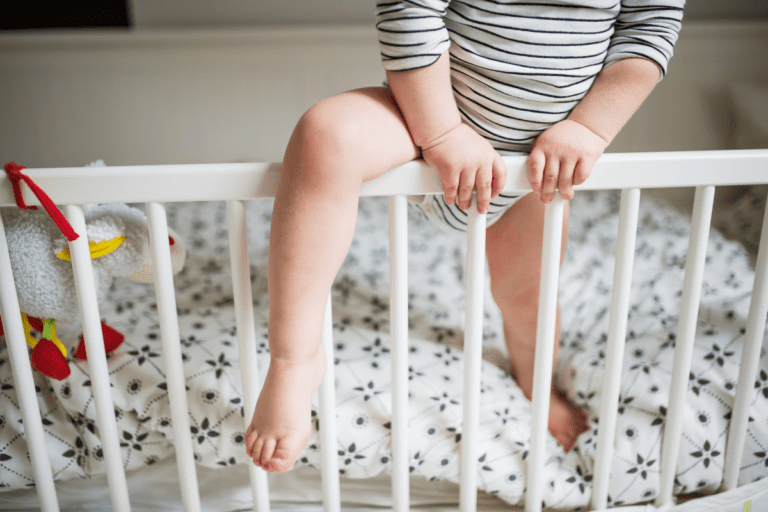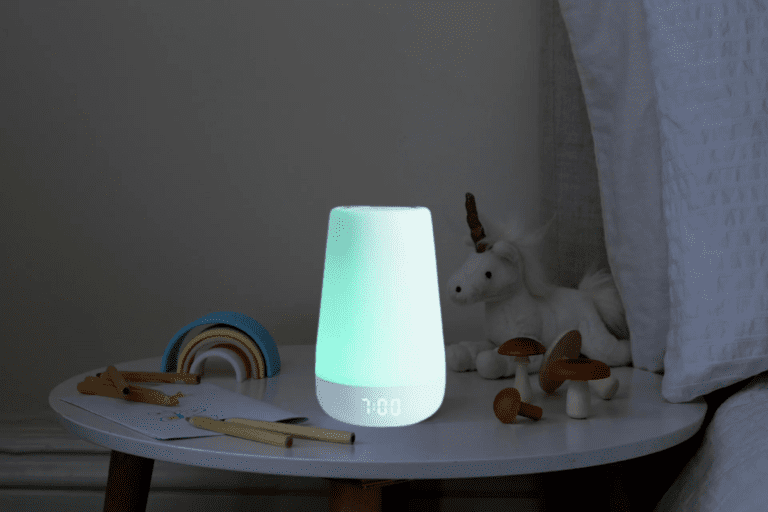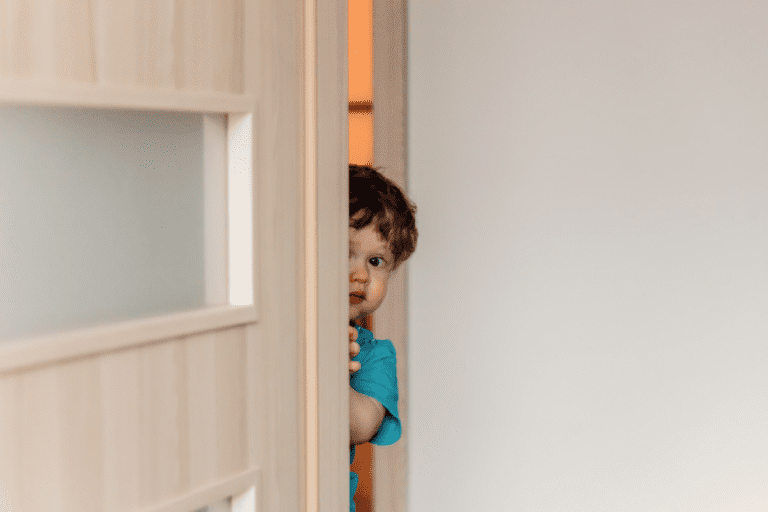The Crib to Big Kid Bed Transition
Before you decide to make the jump from crib to bed I want you consider a few important factors first. How old is your child? If your child is younger than age 3 I recommend holding off on this transition if possible. I have worked with toddlers as young as age 2 in a toddler bed, but I assure you it makes the transition much more challenging.
So why do I recommend waiting longer? Before age 3 your toddler lacks a sense of self-control, which means they won’t be able to resist getting out of bed and leaving their room. Self-control is a learned behavior, and if you make the transition too soon the freedom of a bed can be problematic. Delaying this transition can help prevent some of the pitfalls that come with the crib to bed transition like having a nightly visitor coming to your room.

Is Your Child Climbing Out of the Crib?
Have you tried EVERYTHING to keep your child in the crib, but they’re just an escape artist? While I absolutely recommend keeping your child in a crib until they are 3-3.5 years old, sometimes it’s just not possible.
However, here are some tips to try to prevent crib climbing:
1. Flip the crib around so that the short side is against a wall, even placing the crib in the corner so that there are fewer exit points. The tall side is often tall enough that the child can’t climb out.
2. Use a sleep sack without legs or buy “naughty monkey pj’s” (with a piece of fabric sown between the legs). This will prevent your child from swinging their leg over the crib. If they can take it off, put it on backwards so your child can’t unzip it.
3. Depending on your crib model, take the entire bottom of the crib out, including the spring, so the mattress is on the floor. Make sure this works safely with your crib. There should be no gap between the mattress and the bottom of the crib so that your child can’t get stuck between. This may sound extreme, but this can make it so that your child can no longer climb out (this worked for us).
How skillfully they are climbing? If they are diving out head first, you have to do something right away. If they are not hurting themselves, try calmly returning them to the crib and stating that they are not allowed to get out. Do this 3 or 4 times and if they continue, then return them to their crib without saying anything. Many kids enjoy any attention even if it is negative, so when you don’t react, the game is no longer fun.
If your child is climbing out using upper body strength, and lowering the crib didn’t help, this is a safety issue. You may be forced to transition to the big kid bed if all other options have failed.
Are You Expecting Another Baby?
Are you contemplating making the transition from a crib to a big-kid bed because you need the crib for a new baby? If so I caution you to seek another alternative. If your child is happily sleeping in their crib a new baby is not a reason to boot them out early. Why? First of all, your baby most likely won’t sleep in their crib until 3-6 months of age. A bassinet or pack and play is a great alternative to the crib. Secondly, you don’t want your child to be given this new freedom before they’re ready and definitely not with a baby coming soon after. It’s best to keep big changes like that to one at a time.
However, if you are set on moving your toddler out of their crib and feel that they are developmentally ready I recommend doing it at least a month or more before the new baby arrives. You don’t want them to feel displaced by the new baby, especially if you’re moving them to a new room to give the baby the room with the crib. It will also give them some time to adjust to this change before the new baby arrives.
Are You Hoping a Bed Will "Fix" Your Child's Sleep?
Now, if you’re reading this, chances are that you are hoping to find some advice about teaching your little one the skills they need to sleep through the night. If you’re hoping things will just fall into place once they’re in a big kid bed, I’m sorry to say it’s just not that easy. If your child isn’t a great sleeper now and needs a lot of assistance to fall asleep, then you may find that the crib to bed transition is going to amplify those sleep struggles. Chances are if your toddlers sleep isn’t great now moving them to a bed is not the solution and will most likely make things worse.
There are two reasons why I say this. As I shared earlier, there is absolutely no rush to get your toddler out of their crib and into a bed unless they are climbing out and getting hurt. However, I have seen plenty of 3-year olds sleeping happily in a crib and none of the clients I’ve worked with ever told me, “I wish we’d transitioned him to a big kid bed earlier.” Don’t feel pressured to make the move sooner because of what your friends and family may be saying.
There is a theory out there that suggests the longer a child is in a crib, the more attached they grow to it. And the tougher it is for them to make the transition when they finally do, but I strongly disagree with this theory. The transition is called that for a reason. It doesn’t matter if they love the crib or can’t stop climbing out, it takes time to get used to a bed.
Is Your Child and Independent Sleeper?
The second reason would be if you’re about to start sleep training, meaning your toddler does not fall asleep independently. Moving to a toddler bed and sleep training can be too much all at once. There will be a period of adjustment as your toddler learns to fall asleep independently.
During this adventure, it’s comforting for your little one to have a familiar place to sleep. Her bedroom, her sheets, her lovey, her crib, everything that can stay the same should stay the same until she’s mastered the skills to fall asleep on her own.
Once your toddler is sleeping through the night, the transition to a big kid bed will be a whole lot easier for everyone. A toddler who is well rested and able to fall asleep independently is far less likely to leave their room at night. That is the biggest headache that parents run into when they move their little ones out of the crib.
When Should You Make the Transition?
Ideally the transition should take place after your little one is at least 3 years of age and when they’re showing signs of readiness. If they are asking for a big boy or big girl bed and there are no other big changes happening such as potty training, starting daycare or taking a vacation. Your little one may also be too big for their crib so that can also be another reason to make the switch. So assuming that your little one is already falling asleep on their own and sleeping through the night and you’re ready to move them to a bed.
I recommend going straight to a twin or full-sized bed versus a toddler bed. A toddler bed is no larger than a crib and will be too small soon anyway. I would add a bedrail to the side to keep your child from rolling out. Make sure you are ready to set rules and boundaries with your toddler and willing to enforce them when they test these new rules.
How Do Approach the Transition?
1. Communicate the Changes
The first step is to communicate the change with your child. You’re going to want to fill your little one in on what’s happening. Explain to them that they’re going to be making the move into their new bed and let them know when the switch is going to happen. When you explain everything to your toddler, make sure you do it with a positive spin. You want to balance out your communication so that you prepare your toddler for the switch, but you aren’t overwhelming them with all of this new information. Preparing them ahead of time will help ease any anxiety.
2. Prepare the Room
Now that your toddler is going to have the new found freedom of being in a bed there are things to consider when it comes to their safety:
- Secure any heavy furniture to the wall
- Make sure there is nothing dangling they could get entangled with
- Cover electrical outlets
- Consider removing any extra toys that may disrupt bedtime
3. Let Your Child Make Choices
The exciting part for your toddler will be picking out the bed (unless you already have one) and the new bed sheets. Giving your child some input into which bed they want, what sheets and comforter they like (a favorite character), what pillows feel the most comfortable, will obviously ensure that they get something theylike, but will also help them feel a sense of ownership over their new bed, which can work wonders in easing the transition.
4. Set Clear Rules and Boundaries
You want to try and keep everything else how it was in your toddler’s room except for the new bed. This is a big change, so try not to make any unnecessary additional changes. This goes double for the schedule on the night of the big event. When you’re getting your toddler ready for bed on that first night, don’t alter the routine, don’t switch up bedtime. Keep everything as predictable and mundane as possible.
Prior to bedtime you should talk to your toddler about the rules that come with their new big kid bed. Talk to them about staying in bed all night until you come get them in the morning. It can help to role play this and practice during the day. Depending on the age of your toddler you can also deploy another tactic when needed to help them stay in bed until morning. This works best with kids 2.5 years and up. You can use a toddler clock (my favorites linked here) to teach them that green means morning.

What Happens Next
So now that your toddler’s been put to bed and the light’s been turned out, there are a few different scenarios that can play out. Most often, there’s a honeymoon phase. Your toddler is so excited to be in their new big kid bed that they don’t test boundaries at all. They go to bed easily every night and the parents think, “Wow! That was so easy!”
Then about three to four weeks later, the trouble starts. Now that your child is comfortable in their new bed, they start to get adventurous. They decide to visit mom and dad to see what they’re doing. Or they may ask mom or dad to come lay with them. They can start to test boundaries very gradually by asking for one extra thing like a glass of water or another hug and kiss. Once you grant them this request they keep pushing for more and more.

Using Consequences to Keep Boundaries
All of these behaviors need to be checked right away before they spiral out of control. Toddlers are boundary pushers by nature, but they also clearly understand how long they need to whine for something before Mom or Dad give in. Consequences are a good way to break undesired behaviors so you can keep those boundaries and stop the boundary pushing. Give your child one warning, “You are not allowed to leave your bed and come out of your room, it’s bedtime. If you come out of your room again, then mommy will have to X.”
Once you give the warning you must follow through with the consequence when they repeat the unwanted behavior again. You may have already discovered a consequence that works on your toddler, and I strongly suggest you keep that in place. Again, we don’t want anything to change except for the bed, so keep doing whatever you’ve been doing up until now in regards to managing behavior.
In case you haven’t discovered an effective consequence yet, I find that closing the door all the way and letting it click is a very effective strategy. Nine out of ten toddlers respond well to this “closing the door” strategy. If that doesn’t work, taking the lovey or their stuffed animal away for a short period of time is also a super useful consequence. You may be thinking that taking an item or closing the door is mean, but once they get back into bed you will open the door and return the item.
For each repeat offense, increase the length of time that the door stays closed or the lovey stays out of the bed. You need to follow up with consequences every single time your child breaks a bedtime rule in order for the rules to stick. This same idea applies to the middle of the night and before their clock turns green (if using a clock). For more on how to use consequences, check out my blog post here.
Final Tips and Reminders
There is a possibility that things won’t play out as I’ve described. Maybe they go to bed like an angel every night and never try to get out of bed. In that case, count yourself lucky! On the other hand, your toddler could challenge these new rules and boundaries on night one, so be prepared!
As much as we’re trying to keep this transition as stress-free and smooth as we can, remember this: you are the boss. There’s great certainty that your little one is going to fight this change. She’ll probably leave her room a lot, call for you to come in, ask for a glass of water, and more. She may even say that she wants to go back to sleeping in her crib.
It’s crucial that you hold your ground every step of the way here, especially during the first few weeks. If you start bending the rules and allowing her to climb into bed with you, or letting her get back into the crib, this process is going to go on for months. Stay tough, maintain your authority, and enforce the rules firmly and consistently. It may make you feel a bit harsh at times, but it will get your little one sleeping peacefully in her new bed a whole lot sooner.
Now of course there are going to be times when there are exceptions to these bedtime rules. Your child may wake up scared or crying and say they’ve had a nightmare. In those situations you want to go to your child and offer comfort. I would caution you not to bring them to bed or lay in their bed, as this can create a sleep prop dependency. Offer them comfort and tuck them back into bed, assuring them that they are safe and mom and dad are right down the hall.
If you find yourself in a situation where you need some guidance with your toddler, book a free evaluation call with me. I have helped a ton of parents with toddlers get their children sleeping independently in their own beds all night.


2 thoughts on “The Crib to Big Kid Bed Transition”
Pingback: Is It Time to Drop the Nap? - Happily Ever After Sleep
Pingback: Get Your Toddler to Stay in Bed - Happily Ever After Sleep
Comments are closed.